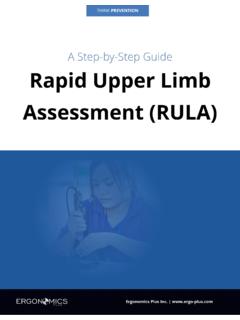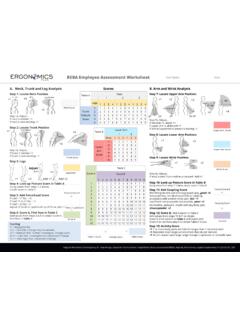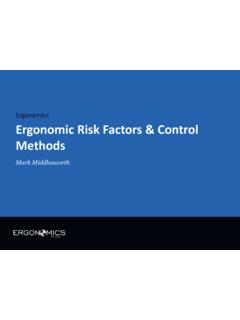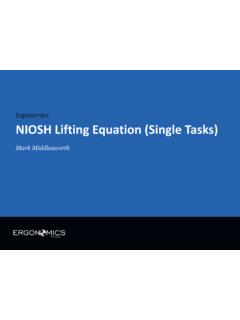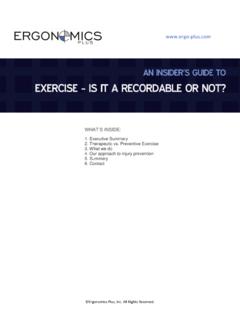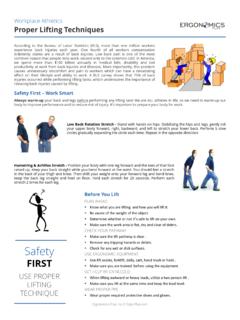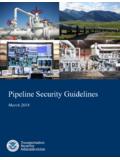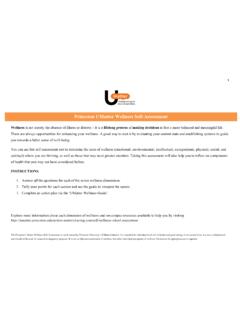Transcription of RULA Employee Assessment Worksheet - ErgoPlus
1 RULA Employee Assessment WorksheetOriginal Worksheet Developed by Dr. Alan Hedge. Based on RULA: a survey method for the investigation of work-related upper limb disorders, McAtamney & Corlett, Applied Ergonomics 1993, 24(2), 91-99A. Arm and Wrist AnalysisStep 1: Locate Upper Arm Position: Step 1a: shoulder is raised: +1If upper arm is abducted: +1If arm is supported or person is leaning: -1 Step 2: Locate Lower Arm Position:Step 2a: either arm is working across midline or out to side of body: Add +1 Step 3: Locate Wrist Position:Step 3a: wrist is bent from midline: Add +1 Step 4: Wrist Twist:If wrist is twisted in mid-range: +1If wrist is at or near end of range: +2 Step 5: Look-up Posture Score in Table A:Using values from steps 1-4 above, locate score inTable AStep 6: Add Muscle Use ScoreIf posture mainly static ( held>10 minutes),Or if action repeated occurs 4X per minute: +1 Step 7: Add Force/Load ScoreIf load < . lbs.
2 (intermittent): +0If load to 22 lbs. (intermittent): +1If load to 22 lbs. (static or repeated): +2If more than 22 lbs. or repeated or shocks: +3 Step 8: Find Row in Table CAdd values from steps 5-7 to obtainWrist and Arm Score. Find row in Table Neck, Trunk and Leg AnalysisStep 9: Locate Neck Position:Step 9a: neck is twisted: +1If neck is side bending: +1 Step 10: Locate Trunk Position:Step 10a: trunk is twisted: +1If trunk is side bending: +1 Step 11: Legs:If legs and feet are supported: +1If not: +2 Step 12: Look-up Posture Score in Table B:Using values from steps 9-11 above,locate score in Table BStep 13: Add Muscle Use ScoreIf posture mainly static ( held>10 minutes),Or if action repeated occurs 4X per minute: +1 Step 14: Add Force/Load ScoreIf load < . lbs. (intermittent): +0If load to 22 lbs. (intermittent): +1If load to 22 lbs. (static or repeated): +2If more than 22 lbs. or repeated or shocks: +3 Step 15: Find Column in Table CAdd values from steps 12-14 to obtainNeck, Trunk and Leg Score.
3 Find Column in Table Arm ScoreLower Arm ScoreWrist ScoreWrist Twist ScorePosture Score AMuscle Use ScoreForce / Load ScoreWrist & Arm ScoreNeck ScoreTrunk ScoreLeg ScorePosture B ScoreMuscle Use ScoreForce / Load ScoreNeck, Trunk, Leg ScoreScores=++=++Scoring: (final score from Table C)1-2 = acceptable posture3-4 = further investigation, change may be needed5-6 = further investigation, change soon7 = investigate and implement changeRULA ScoreTask Name: Date: +1+2+2+3+4+1+2+3 Add +1+1+2+3+4+1+2+3+4

